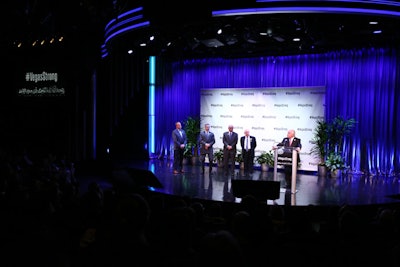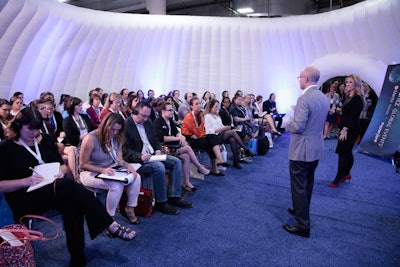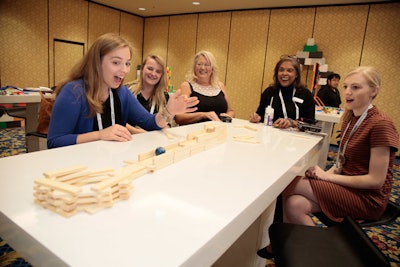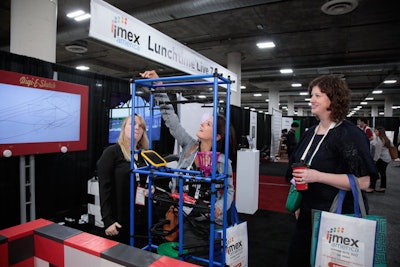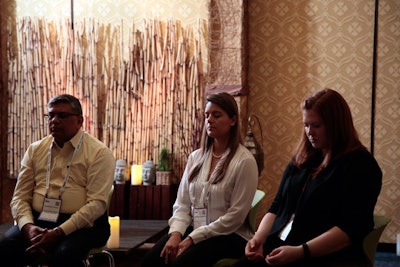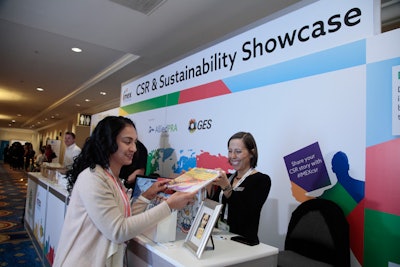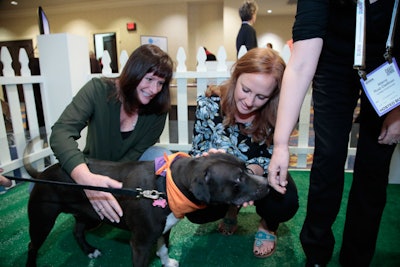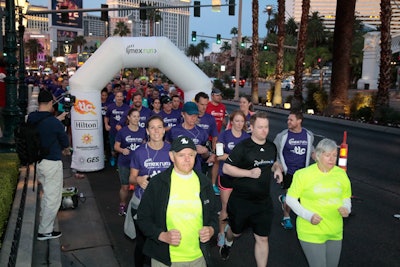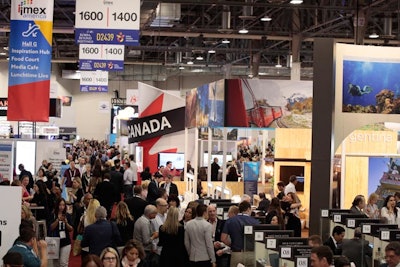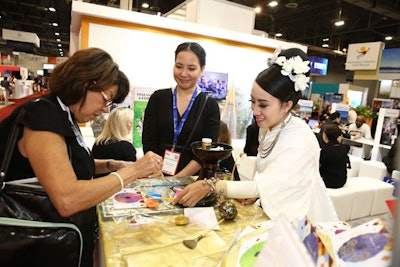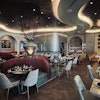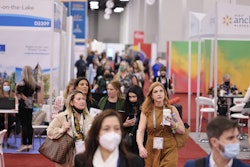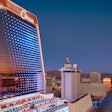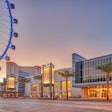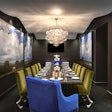The seventh incarnation of the IMEX America meeting industry convention, which wrapped last week in Las Vegas, was the biggest yet. More than 3,300 companies representing 150 countries exhibited this year, including 64 new booths. The show’s education offerings also broke records, with a major expansion of the education area and over 250 education sessions.
In total, more than 12,000 exhibitors, hosted buyers, and other attendees participated in the event, which officially ran from October 10 to 12 at the Sands Expo at the Venetian and Palazzo. (About 1,000 event professionals started their week a day early with MPI’s “Smart Monday,” which featured a variety of events and education sessions.)
While topics of technology, food and beverage, and venue choice still led to jam-packed sessions, some unexpected themes emerged from both formal session content and informal networking sessions, media lunches, and evening parties. Security was obviously a hot-button issue as people were thinking about the mass shooting that had taken place in Las Vegas the week before. Other topics of conversation centered on the rise of experiential activities, the importance of wellness and C.S.R., and the idea of “purposeful meetings.”
Here’s a look at what the audience of meeting planners and hospitality pros had to say.
1. Meetings aren’t just about content.
This year’s official convention theme was “purposeful meetings”—basically, thinking of attendees as humans first, which requires studying how they learn, think, connect, and perform, then planning accordingly.
Janet Sperstad, program director at Madison College in Wisconsin, delivered a Monday-morning keynote on the topic. Centered on a new industry white paper she led called “Purposeful Meetings: How to Plan With Deeper Meaning, Innovation, and Insight in Mind,” Sperstad discussed ways to leverage event design, technology, and more to create better, more creative, more comfortable meetings.
Sperstad suggested adding in cognitive breaks to refresh the mind and putting the most complex meeting content in the morning or directly after lunch. She also mentioned that audio-scraping, lighting, or guided meditation can make brains more receptive to learning, and that events should offer quiet areas where people can unplug or even take short power naps. In addition, Sperstad suggested giving attendees a sense of belonging and meaning through hands-on C.S.R. and sustainability programs.
“Think beyond T-shirts, lanyards, places, and spaces—to people,” she said.
These tips were put into action throughout the convention with several new and returning initiatives. Hilton sponsored the Be Well Lounge, where IMEX attendees could get massages during the day or take part in guided meditations from Lee Papa, a mindfulness speaker and trainer. The early-morning #IMEXRun on Wednesday drew over 450 runners, and Smart Monday attendees could de-stress between sessions by playing with therapy dogs. Guests could also donate books to Spread the Word Nevada, a local children’s literacy nonprofit.
[PULLQUOTE]
2. Planners want hands-on learning methods and creative meeting spaces.
Building on the idea of purposeful meetings, the event featured an increased focus on experiential activities and creative learning styles. The brand-new “Lunchtime Live Zone” showcased artists, musicians, and games with the purpose of inspiring planners to bring creative ideas to their own meetings. Guests could play with a giant Etch-a-Sketch or take a virtual-reality roller coaster ride, then have their faces depicted in sand and receive a custom song from the team at Song Division. In addition, Hilton hosted a digital graffiti wall, located near registration, where customers could take selfies then decorate them with a digital spray can and share on social media.
In the expanded “Inspiration Hub” education area, meetings and seminars took place inside intimate inflatable domes designed to spark creativity and teamwork. The area was also home to the “Play Room.” Sponsored by teambuilding company Play With a Purpose, the room was a hands-on, interactive learning space designed to provide tools to make meetings more engaging. One session discussed how to use escape rooms for events, while another focused on fun ways to engage introverts.
Regular sessions took on more creative formatting as well. For example, in a Smart Monday education panel, Jessie States, manager of professional development at MPI, used a “spectrogram” format, where participants were asked to form a line based on their position on a specific topic or issue. The format encouraged attendees to share their experiences and stories with each other, and raised the energy level in the room.
Amy Allen, director of sales and marketing at the Grand Teton Lodge Company in Wyoming—part of Vail Resorts—noted that she's seeing that sort of out-of-the-box thinking at her resorts as well. "Planners seem to be looking for more creative choices for their meeting experiences—especially in destinations like ours where attendees really want to get outside," she said. "We’ve seen groups do walking or hiking meetings; we’ve even had groups at our ski resorts do small breakout meetings on the gondola or chairlift, up the mountain and then back down again."
Finally, the Thursday-morning keynote focused on “the power of live,” with an energetic session by Brent Bushnell, C.E.O. of experiential entertainment company Two Bit Circus. “Nothing beats the live experience, and there’s an increasing appetite for creative events that are interactive and experiential,” he explained. “The key here is to involve attendees. They shouldn’t just be passive observers, but need to actively engage. Hands-on projects require decision-making and engage more of a person’s brain, leading to embedded learning.”
3. Event security is more important than ever—and so is the hospitality industry.
The week kicked off with an emotional press conference addressing the shooting in Las Vegas, which had taken place 10 days prior a few miles up the Strip. Ray Bloom, chairman of the IMEX Group, said he was happy to see participants from 150 countries coming together to support the event industry—and to support Las Vegas. “When we arrived here, we were greeted in a normal manner by our friends, people we’ve known since we started here seven years ago. Behind that, we knew they were hurting.”
Jim Murren, chairman and C.E.O. of MGM Resorts International, noted that 50,000 people who work for MGM Resorts in Las Vegas rely on meetings and conventions for their livelihoods. “I’ve never been more proud in my life of any organization as I am right now of my organization,” he said. “Not because we try to deliver service at that excellent level, but because we try to help one another in ways that are unimaginable. … We’re working together to heal this community, our city, our industry. And we know the meetings and conventions business is the backbone of our business model.”
Speakers at the press conference also addressed recent natural disasters, such as the hurricanes that hit Texas, Florida, and Puerto Rico and the ongoing fires in Northern California. Roger Dow, C.E.O. of the U.S. Travel Association, said, “I’m here to voice support for the $2.3 trillion, 15-million-employee U.S. travel industry, an incredibly strong industry. And also, as we’ve found, an incredibly fragile industry,” noting that fear of disasters or terrorism can “bring the industry to its knees.”
He continued, “Each of us has a job to talk about every successful convention, every record broken, [to encourage everyone] to say, ‘Las Vegas, you’ve been with us for the good times, and we stand with you in these toughest of times, and we add our voices to the 43 million voices [of those who visit the city annually] that say Las Vegas is stronger than ever, and we’re with you all the way.’”
The rest of the week also addressed security issues, with panels on cyber safety for meetings and events, the travel ban, strategies for conflict resolution, and ways to mitigate risk when dealing with event data.
In addition, Puerto Rico hosted a press conference during the convention, and had a booth on the show floor. Milton Segarra, C.E.O. and president of Meet Puerto Rico, noted that while the island suffered tragedy and destruction from Hurricane Maria, news photos give the impression that the island is incapable of being visited—which is not true, he said. According to Segarra, 75 percent of ports and 80 percent of gas stations are open, and by the end of October, all flights into Luis Munoz airport should be back to a regular schedule. Within the next few weeks, he says, most hotels will be accepting reservations immediately.
"I live in Puerto Rico and I know exactly what we’ve been going through,” he said. "But the reality is this: Tourism is a very important economic development component. … There are 75,000 people that work and depend on the tourism industry in Puerto Rico."

